
Classroom Lab Field Trip Programs
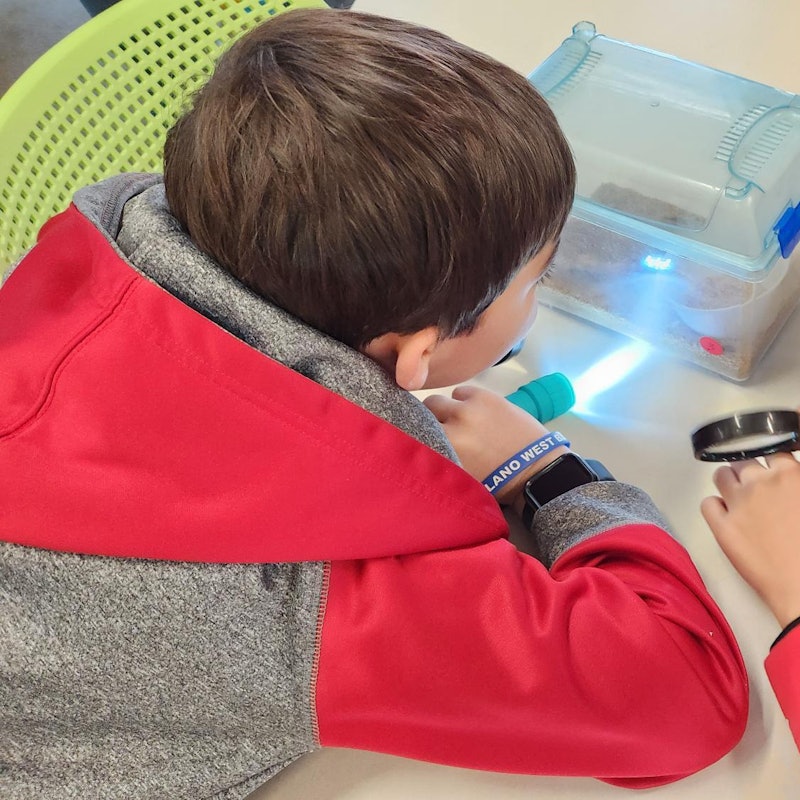
Details
TEKS-aligned classroom lab programs are offered for K–6th grade on-site in the Main Garden.
- Monday–Friday
- Kinder-6th Grade
- $12 per student | 1:8 teacher/chaperone free
- $15 per additional chaperone
- Children’s Adventure Garden access included
- Up to 30 students per session
Looking for classroom lab programs at your school? Explore our Garden on the Go offerings!

Pumpkin Physics
3rd-5th Grade Available
September 23–November 1
Calling all engineers! Students will engage in the engineering design process to help solve a problem at the Arboretum– how can we move an 80-lb pumpkin? They will apply what they know about force, motion, and energy to design and test a model catapult that can launch a candy pumpkin.
TEKS:
Science and Engineering Practices:
- 1B, 1C, 1D, 1E, 1F, 1G, 2B, 2D, 3A, 3B, 3C, 4A
Recurring Themes and Concepts:
- 5B, 5D, 5E
Science Content:
- 3.7A, 3.7B
- 4.7A. 4.8A
- 5.7A, 5.7B
- 6.7A, 6.8A

Seedsational
K-2nd Grade
Available February 24–May 30
In this lab, students will discuss characteristics of living things and use those characteristics to differentiate between living and non-living things. They will explore the life cycles of plants, learning about the different ways seeds travels. Students will then observe seeds inside a cantaloupe and compare cantaloupe seeds to a variety of other seeds. Students will dissect a lima bean seed, discuss how a new plant grows from a seed, and then plant their own seed for continued observation at home.
TEKS:
Science and Engineering Practices:
- 1D, 1E, 2B, 3A, 3B, 3C
Recurring Themes and Concepts:
- 5A, 5F, 5G
Science Content:
- K.12A, K.13A, K.13C, K.13D
- 1.12A
- 2.13A

Earth Rocks!
K-2nd Grade
Introduce your students to the world of geology as they take a closer look at rocks. In this program, students observe a diverse sample of rocks and sort the rocks by size, shape, color and texture. Students also observe a variety of everyday products that are made from rocks and identify the properties of the rocks used to make each product.
TEKS:
Science and Engineering Practices:
- 1D, 1E, 1F, 2B, 2C, 3A, 3B, 3C, 4A
Recurring Themes and Concepts:
- 5A, 5C
Science Content:
- K.6A, K.10A, K.11A
- 1.6A, 1.11A
- 2.6A, 2.11A

Plant Detectives
K-2nd Grade
Do all leaves look the same? What about stems and roots? In this lab students identify basic plant parts and investigate plant diversity by comparing and contrasting the unique structures of live plants. Older students also explore how different structures allow plants to meet their needs.
TEKS:
Science and Engineering Practices:
- 1D, 1E, 1F, 1G, 3A, 3B, 3C
Recurring Themes and Concepts:
- 5F
Science Content:
- K.12A, K.13A
- 1.12A
- 2.13A
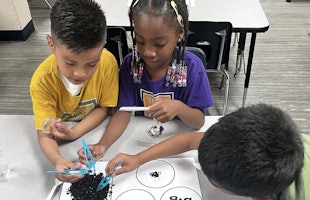
The Scoop on Soil
K-2nd Grade
Take a closer look at soil! Students work in groups to observe a soil sample from the Arboretum grounds and sort out the components that make up the soil. Groups then compare their observations with each other and examine how scientists learn from samples.
TEKS:
Science and Engineering Practices:
- 1D, 1E, 2B, 3A, 3B, 3C
Recurring Themes and Concepts:
- 5A, 5C, 5D
Science Content:
- K.6A, K.11A
- 1.6A, 1,10A, 1,11A
- 2.6A
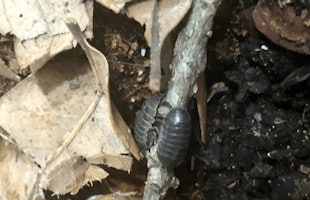
What’s For Dinner
K-2nd Grade
Like all ecosystems, the Arboretum is a complex and active place, filled with interconnected organisms. In this lab, students explore small but significant members of our ecosystem: pill bugs. Students observe terrariums with live organisms to investigate living and nonliving things, basic needs of organisms and energy transfer in food chains.
TEKS:
Science and Engineering Practices:
- 1D, 1E, 1F, 2B, 3A, 3B, 3C
Recurring Themes and Concepts:
- 5D, 5E, 5F
Science Content:
- K.12B
- 1.12A, 1.12B, 1.12C
- 2.12B

It’s a Bug’s Life
2nd-5th Grade
The Arboretum is home to hundreds of plant and animal species, including many bugs! In this program, students identify ‘bug’ as an informal name given to terrestrial arthropods and observe live organisms to identify the traits that make insects different from other arthropods. Students look closely at various arthropod adaptations that support survival in different environments and investigate the unique life cycles of different organisms.
TEKS:
Science and Engineering Practices:
- 1C, 1D, 1E, 1F, 2B, 3A, 3B, 3C
Recurring Themes and Concepts:
- 5A, 5F
Science Content:
- 2.13B, 2.13D
- 3.13A, 3.13B
- 4.13B
- 5.13A

Purposeful Pollinators
2nd-6th Grade
What is the purpose of pollination? In this lab, students will construct and use models of insects and flowers to investigate the process of pollination. They will examine the structures and functions of plants and pollinators that allow this process to occur and explore how it benefits both plants and animals.
TEKS:
Science and Engineering Practices:
- 1D, 1E, 1G, 3A, 3B, 3C
Recurring Themes and Concepts:
- 5D, 5F
Science Content:
- 2.12C, 2.13A, 2.13B
- 3.13A
- 4.13A
- 5.12A

Disappearing Act
3rd-6th Grade
What happens when an organism in an ecosystem disappears? Students first investigate 3 organisms: white-tailed deer, post oak trees and grey wolves and then create a model of the Post Oak Savannah to actively simulate how the local extinction of wolves in this area affects all components of the ecosystem. Each student acts as either a wolf or a deer in this engaging, interactive lab.
TEKS:
Science and Engineering Practices:
- 1E, 1F, 1G, 2B, 2C, 3A, 3B, 3C
Recurring Themes and Concepts:
- 5B, 5D, 5E, 5F, 5G
Science Content:
- 3.12B, 3.13A
- 4.12B, 4.13A
- 5.12A, 5.12B, 5.12C
- 6.12A, 6.12B, 6.12C
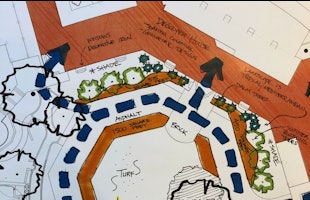
Garden Design Challenge
3rd-6th Grade
What environmental factors and landscape design choices must our horticulture staff consider when designing our seasonal plantings? In this multi-disciplinary lab, students work with actual Arboretum plant lists and design notes to create a landscape in the garden. Follow up the class with a visit to the space students just designed!
TEKS:
Science and Engineering Practices:
- 1D, 1E, 1F, 1G, 2B, 3A, 3B, 3C, 4A, 4B
Recurring Themes and Concepts:
- 5A, 5B, 5C, 5D, 5G
Science Content:
- 3.12A
- 4.12A
- 5.12A
- 6.12A

Restless Earth
3rd-5th Grade
Every place has a story. In this lab, students explore the slow processes that create geological change: weathering, erosion and deposition. 3rd and 4th grade students investigate how these processes lead to the formation of soils and use this information to explain why soils have different properties. 5th grade students identify how these processes lead to the formation of landforms and use this information to explain why certain places look the way they do and predict how areas could change in the future.
TEKS:
Science and Engineering Practices:
- 1E, 1F, 1G, 2B, 3A, 3B, 3C
Recurring Themes and Concepts:
- 5B, 5C, 5G
Science Content:
- 3.10B
- 4.10B
- 5.10C
We also offer classroom labs for 3rd-5th grade students designed to support specific grade level TEKS in all four reporting categories.
Third Grade Lessons

Diving into Physical Properties
How do our actions in North Texas contribute to the issue of marine debris? In this lesson students will explore how trash enters our waterways and ultimately flows to the ocean. They will then investigate an issue closer to home by making observations of a collection of objects that fell into one of the Arboretum’s water features. After determining the physical properties of each object, students will advise Arboretum staff on the best tool to use to retrieve each object.
TEKS:
Science and Engineering Practices:
- 3.1D, 3.1E, 3.1F, 3.2B, 3.3A, 3.3B, 3.3C
Recurring Themes and Concepts:
- 3.5F
Science Content:
- 3.6A
- 4.10B
- 5.10C

Energy in the Garden
How can we use different forms of energy to solve problems that arise in a garden? After exploring, describing and identifying four forms of energy (mechanical, light, thermal and sound) in everyday objects, students are presented with garden scenarios. They are then challenged to design strategies to address the problems using different forms of energy.
TEKS:
Science and Engineering Practices:
- 3.1D, 3.1E, 3.1F, 3.2B, 3.3A, 3.3B, 3.3C
Recurring Themes and Concepts:
- 3.5B, 3.5E
Science Content:
- 3.8A

Rapid Changes
How do volcanoes, earthquakes and landslides impact Earth’s surface? Students explore images that show the aftermath of volcanoes, landslides and earthquakes. Then they use models to further investigate these geological processes. Students are challenged to describe a strength and weakness of each model.
TEKS:
Science and Engineering Practices:
- 3.1C, 3.1D, 3.1E, 3.1F, 3.1G, 3.2B, 3.3A, 3.3B, 3.3C
Recurring Themes and Concepts:
- 3.5B, 3.5C, 3.5G
Science Content:
- 3.10C

Models: Sun, Earth & Moon
Take a bird’s-eye view of space! Students first create a human-sized model to demonstrate the relative positions of the Sun, Earth and Moon and the orbits of the Earth and our Moon. Then, they use 3D printed models to demonstrate the same concepts, in a different way. Finally, students are challenged to create their own 2D model to demonstrate their understanding.
TEKS:
Science and Engineering Practices:
- 3.1D, 3.1E, 3.1F, 3.1G, 3.2A, 3.3A, 3.3B, 3.3C
Recurring Themes and Concepts:
- 3.5A, 3.5B, 3.5C, 3.5D
Science Content:
- 3.9A

Ecosystems in Action
What happens when the top predator leaves an ecosystem? In this lab, students identify the physical characteristics and ecological roles of 5 organisms: red wolves, post oak trees, turkey vultures, white-tailed deer and earthworms. Then, they create a food web to show how energy flows through this ecosystem. Finally, students play a game to explore how the local extinction of the red wolf in the eastern half of Texas impacts the entire food web.
TEKS:
Science and Engineering Practices:
- 3.1E, 3.1F, 3.1G, 3.2B, 3.3A, 3.3B, 3.3C
Recurring Themes and Concepts:
- 3.5B, 3.5D, 3.5E, 3.5G
Science Content:
- 3.12B

Life Cycles
Let us bring our live organisms to you! In this lesson students will make observations of four different arthropods at various stages in their life cycles and identify similarities and differences in how these organisms change over time.
TEKS:
Science and Engineering Practices:
- 3.1C, 3.1D, 3.1E, 3.1F, 3.3A, 3.3B, 3.3C
Recurring Themes and Concepts:
- 3.5A, 3.5G
Science Content:
- 3.13B
Fourth Grade Lessons

Matter Over Time
What happens to our trash over time? In this lab, students first measure and record physical properties of a “fresh” piece of trash. Then, they measure and record the physical properties of that same type of trash that has been buried in soil for multiple weeks. Students use this data to discuss what happens to trash in a landfill and discuss what we can do to reduce the amount matter that is added to landfills.
TEKS:
Science and Engineering Practices:
- 4.1D, 4.1E, 4.1F, 4.1G, 4.2B, 4.3A, 4.3B, 4.3C
Recurring Themes and Concepts:
- 4.5G
Science Content:
- 4.6A, 4.11B
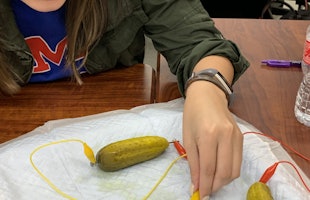
Pickle Powered
Can a pickle light a lightbulb? First, students differentiate among forms of energy, including mechanical, electrical, light, thermal and sound. Then, they identify these various forms of energy in electrical circuits and experiment with building a pickle battery, creating a circuit which powers a lightbulb.
TEKS:
Science and Engineering Practices:
- 4.1C, 4.1D, 4.1E, 4.1F, 4.3A, 4.3B, 4.3C
Recurring Themes and Concepts:
- 4.5B, 4.5E
Science Content:
- 4.8B, 4.8C

Slow Changes
How has Earth’s surface changed over time? In this lab, students model and investigate the processes of weathering, erosion and deposition. Then, they create explanations about how these processes have slowly changed the surface of the Earth.
TEKS:
Science and Engineering Practices:
- 4.1E, 4.1F, 4.1G, 4.2B, 4.3A, 4.3B, 4.3C
Recurring Themes and Concepts:
- 4.5B, 4.5C, 4.5G
Science Content:
- 4.10B

Earth’s Water Cycle
In this lab, students will move through 5 stations to investigate various components of the water cycle. They will identify how models can be used to represent natural phenomena and explore the sun’s role in the continuous movement of water above and on the surface of Earth.
TEKS:
Science and Engineering Practices:
- 4.1C, 4.1D, 4.1E, 4.1F, 4.1G, 4.3A, 4.3B, 4.3C
Recurring Themes and Concepts:
- 4.5A, 4.5B, 4.5D, 4.5E
Science Content:
- 4.10A

Energy in Ecosystems: Food Webs
How does energy flow through an ecosystem? Students will dissect owl pellets to discover what these birds of prey eat. They will then create a food web describing the flow of energy in the owl’s ecosystem.
TEKS:
Science and Engineering Practices:
- : 4.1C, 4.1D, 4.1F, 4.2B, 4.3A, 4.3B, 4.3C
Recurring Themes and Concepts:
- 4.5D, 4.5E
Science Content:
- 4.12B
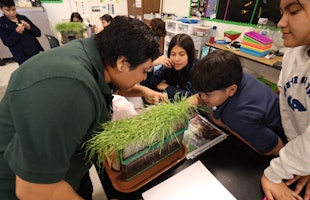
Amazing Adaptations: Plants
After reviewing the basic structures and functions of plants, students work through three stations to observe and describe a diverse selection of leaves, stems and roots. Students then learn about different Texas environments and infer, based on their observations, which plant grows best in each environment.
TEKS:
Science and Engineering Practices:
- 4.1C, 4.1D, 4.1E, 4.1F, 4.2B, 4.3A, 4.3B, 4.3C
Recurring Themes and Concepts:
- 4.5B, 4.5F
Science Content:
- 4.13A
Fifth Grade Lessons

Sorting Out Mixtures
What is a mixture? In this lab, students will first identify the differences between heterogeneous mixtures and solutions. They will then work in groups to create mixtures from a collection of beads and make observations of the physical properties of the mixture as compared to the physical properties of the ingredients. Finally students will explore soil as a mixture and investigate the ingredients that make up soil.
TEKS:
Science and Engineering Practices:
- 5.1D, 5.1E, 5.1F, 5.2B, 5.3A, 5.3B, 5.3C
Recurring Themes and Concepts:
- 5.5F
Science Content:
- 5.6B

Garden Art: Reflection and Refraction
How does light travel? In this lesson, students will first complete three investigations to explore how light travels in a straight line and changes direction when reflected or refracted. They will then be challenged to use what they learned about light to design a prototype of an art piece for the Dallas Arboretum.
TEKS:
Science and Engineering Practices:
- 5.1D, 5.1E, 5.1F, 5.2B, 5.3A, 5.3B, 5.3C
Recurring Themes and Concepts:
- 5.5B, 5.5E
Science Content:
- 5.8C

Exploring Day and Night
Why do we experience day and night? First, students make observations of a time-lapse video of the setting sun. Then, they experiment with two different models and construct an explanation based on direct and indirect evidence, to explain the cause of the day and night cycle.
TEKS:
Science and Engineering Practices:
- 5.1E, 5.1F, 5.1G, 5.2B, 5.3A, 5.3B, 5.3C
Recurring Themes and Concepts:
- 5.5A, 5.5B, 5.5D
Science Content:
- 5.9A
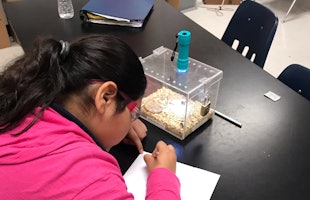
Eco Flow: Interdependence
Our arthropod collection will travel to you! In this lab, students observe live tarantulas, walking sticks, pill bugs and beetles in their habitats and identify interactions between living and nonliving components in these ecosystems.
TEKS:
Science and Engineering Practices:
- 5.1C, 5.1D, 5.1E, 5.1F, 5.2B, 5.3A, 5.3B, 5.3C
Recurring Themes and Concepts:
- 5.5B, 5.5D, 5.5E, 5.5G
Science Content:
- 5.12A

All About Ants
Let us bring our ant farm collection to your classroom! In this lab, students explore and describe physical and behavioral traits while observing live ants. First, students observe and identify the traits ants share with all insects and the traits that make ants unique. Then, they discuss the behaviors of these social insects and identify the instinctual and learned behavioral traits that help ants survive.
TEKS:
Science and Engineering Practices:
- 5.1C, 5.1D, 5.1E, 5.1F, 5.2B, 5.3A, 5.3B, 5.3C
Recurring Themes and Concepts:
- 5.5A, 5.5F
Science Content:
- 5.13B